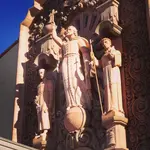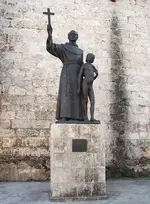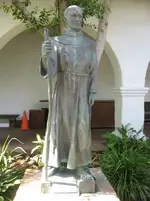Hola amigos,
Most of this is addressed to our mutual amigo Cactusjumper Joe, whom I still have some hopes of convincing about this subject, and the post got very long-winded so please feel free to skip it, otherwise I must beg your indulgence yet again. Thank you in advance.
Cactusjumper wrote
ahh.....Just find and post stuff like that to impress folks.
I asked because I was surprised you had never mentioned those letters with rather dammin' evidence, thinking perhaps you had missed them,
and the possibility that the ONLINE version may have different materials from the book you have. I have found this to be the case with other books, the materials online are not a complete match for a published book even when on the same topic.
Cactusjumper also wrote
It's true that I can find reasons for what he wrote that don't match your own reasoning. The Jesuits did deal in gold and silver for payments on the goods they supplied to the mines and other Spanish needs. Without a "gold scale", would Segesser simply eyeball the proper amount of gold needed for the goods sold?
Segesser makes NO mention of selling ANY supplies to the Spanish, and includes a request for
crowbars in his lists of things to ship. Does he need six crowbars to open the purses of the Spanish? Are crowbars of much use in farming, where the farm fields as he noted have NO ROCKS? More on this in a moment, but how can you read this pair of sentences:
[Anyone whom I hire] immediately acts arrogantly and requires supervision by the father missionary, and later must be paid 500 to 600 Spanish thalers, which cost a lot of sweat and labor to come by. After all, because of the constant riots of the Indians one cannot work securely in the silver and gold mines [literally: mountains].
- in any way other than
Segesser is complaining that money to pay a hired hand is hard to come by, since he cannot work securely in the silver and gold mines due to the constant threat of Indian attacks? Remember he mentioned having to oversee EVERY enterprise of his Indians too.
Cactusjumper also wrote
A gold mine found near a mission would surely bring miners, their families as well as people to support the enterprise and by extension, the mission. The next thing you know.......ya got civilization.
The lands around the missions were largely considered the property OF the missions, and a mine located in Mission property would hardly be Spanish property. Here is that statement for those whom have not seen it:
In the meantime few events have occurred that would be worth to be reported, except that not far from here a goldmine was discovered. They say that it is very rich.
May God grant that this will be true. Then this mission will recover a little, after it has, as I have told you previously, suffered many losses because of the constant unrests by the hostile neighbors and because of the need to entertain guests and soldiers who either stay here or pass through.
Letter to his brother Ulrich Franz Joseph Segesser. San Miguel de los Ures, June 17,
1754 <pp 192>
Segesser does NOT say that Spaniards discovered a gold mine near his mission, and does state that if it is true his mission will recover a little as a direct result of this mine, and also mentions the drain on resources from Spaniards whom visit
and never offer to pay for what they consume. Also if your take on those passages were the correct one, would not an influx of Spanish miners and their families, mean an influx of people almost certain to come into direct conflict with his Indians, not to mention a further drain on his food and livestock
without payment?
The fact that Segesser repeatedly complains about the Spanish passing through, demanding food and lodging, horses etc NEVER PAYING FOR THEM, certainly flies in the face of the assumption about the missions SELLING all kinds of foodstuffs and supplies to the same Spaniards. Don't you see a problem with that version of events? If Segesser were really SELLING to the Spaniards and this were the source of such incomes, he would rather then
desire more Spanish visitors, rather than complaining they arrive all too often, or is my logic flawed there?
In my opinion there really is no other way to interpret Segesser's letters; he has need of a gold scale because he is in the Silver mountains country and this silver mining is a part of his mission's enterprises, he is pestered by Spanish visitors whom eat the mission foods and remove livestock without ever paying for them and he is unable to work the mines very much due to the threat of hostile Indians.
As to his poverty, he is another example of the contradictions you can find in almost every Jesuit mission; personally he is not too wealthy but is able to send away for things in faraway Europe, including some rather nice things, and mentions plunking down 2500 Spanish dollars to pay for some work, though his stipend is only 350 dollars per annum. Where did he get that large sum? Certainly Segesser was not working to
personally enrich
himself by the proceeds of the "many businesses" he complains of having to manage.
As to those whom believe the padres had NO involvment in any mining, note that
Segesser also repeatedly complains about having to personally oversee ALL kinds of work, and not being able to fully entrust this management to anyone. Again, he writes of having lost 16 of "HIS" horses, killed by hostiles, and a further 50 head stolen besides - not horses belonging to the Mission nor to the Indians, (which in their view as a legal sense, were one and the same for Indians were not allowed to own property, being equivalent to minor children in the law) and I could point out that 65 horses would make for a fairly well-heeled person in the 1700s on the frontier, certainly wealthy in many Indian tribal terms.
Even those lists of things which father Segesser is requesting his relatives to obtain and ship to him from Europe,
are not asked for without his promise to pay for them. In another letter Segesser mentions his plan to send a "golden ball" to another father, so that he will not have to live in penury - what sort of a "golden ball" would allow a man to live more comfortably, unless it is actually made of gold? Doesn't the "golden ball" sound a bit too reminiscent of the round balls of gold, covered in chocolate discovered by the authorities being shipped by the Jesuits?
The mines of the Jesuits were only one aspect of their enterprises; farming and ranching, sugar refining, banking, even retail stores were among their many and varied business pursuits. It certainly appears that a big reason these mines were not operated on a much larger scale, was the presence of hostile Apaches and Seris, as well as the padres inability to be everywhere at once, as so many of the Jesuit padres complained, their mission Indians would not work hard unless driven to it.
Good luck and good hunting amigos, I hope you find the treasures that you seek.
Oroblanco




 I believe you are aware that I have all of the letters, and I can assure you I have read each and every one of them. It helps to read all of the individual letters, and not just post parts of them. What is written just before quotes, and after, is often very important.
I believe you are aware that I have all of the letters, and I can assure you I have read each and every one of them. It helps to read all of the individual letters, and not just post parts of them. What is written just before quotes, and after, is often very important.





